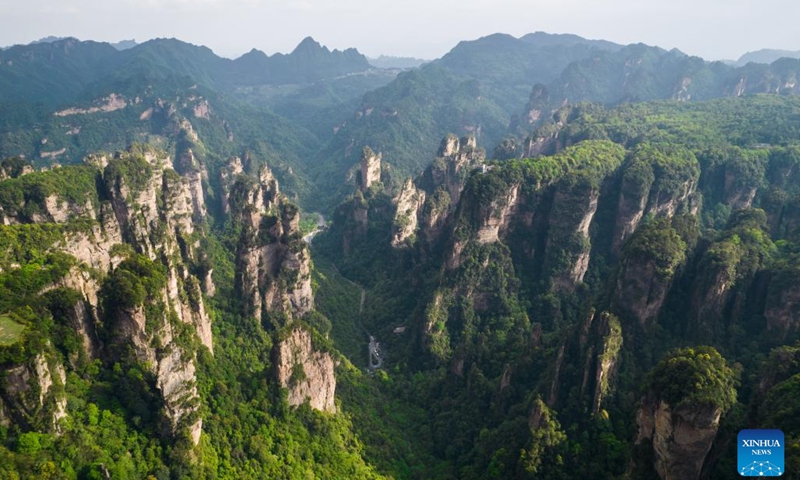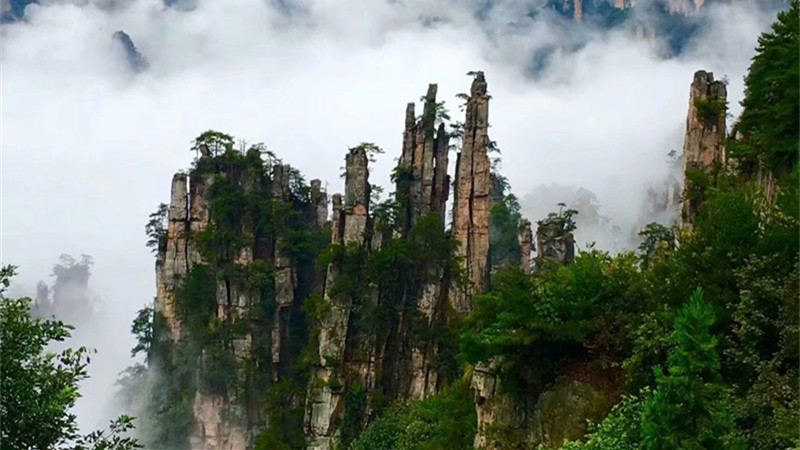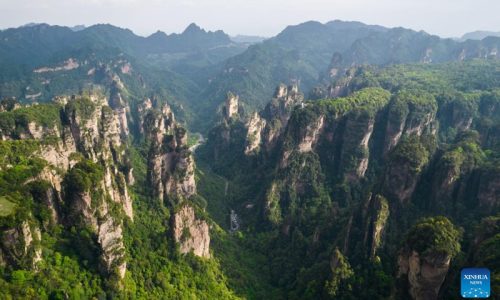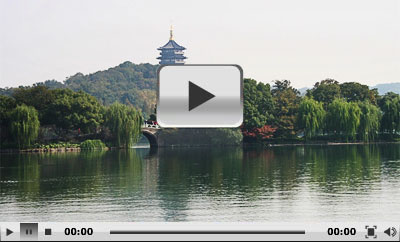Discover the Natural Wonders of Wulingyuan Scenic Area in Hunan Province, China
Wulingyuan Scenic Area in Hunan Province, China, stands out as one of the most breathtaking natural landscapes in the world, renowned for its towering sandstone pillars, lush forests, and unique geological formations. This UNESCO World Heritage site offers visitors an unparalleled experience of nature’s artistry, showcasing over three thousand quartzite sandstone peaks that rise dramatically from the ground, creating a surreal skyline. Exploring the area provides a deep insight into the geological processes that shaped this extraordinary terrain, making it a must-visit destination for nature lovers and adventure seekers alike. The scenic area is also home to diverse flora and fauna, protected within designated conservation zones, ensuring the preservation of its rich biodiversity. Whether you’re hiking along scenic trails, capturing stunning photographs of the majestic pillars, or discovering hidden caves and waterfalls, Wulingyuan Scenic Area in Hunan Province, China, offers an unforgettable journey into the heart of natural beauty. For those interested in geology and landscape photography, this region presents countless opportunities to witness the harmonious blend of natural forces that have sculpted this magnificent environment over millions of years. To learn more about this remarkable destination, visit our detailed guides and plan your visit to experience the awe-inspiring scenery firsthand.
Wulingyuan Scenic Area-Iran Charter

Discovering Wulingyuan Scenic Area in Hunan Province, China: A Natural Marvel
Wulingyuan Scenic Area in Hunan Province, China, stands as one of the most breathtaking natural wonders in the world. Famous for its towering quartz sandstone pillars, this UNESCO World Heritage site offers visitors an unparalleled landscape of over 3,000 vertical formations that rise dramatically from the lush forested valleys below. The area’s unique geological features have made it a must-visit destination for nature lovers, geologists, and adventure seekers alike. Exploring Wulingyuan provides an immersive experience into the heart of China’s extraordinary natural beauty and geological history.
The Geological Foundations of Wulingyuan in Hunan Province, China
The formation of Wulingyuan Scenic Area in Hunan Province, China, dates back millions of years, shaped by complex geological processes involving sedimentation, erosion, and tectonic activity. The region’s distinctive quartz sandstone pillars are the result of long-term weathering and erosion, which have sculpted the landscape into its current form. These towering structures are composed primarily of resistant quartz-rich sandstone, allowing them to withstand natural forces over millennia. Understanding the geological history of Wulingyuan reveals the powerful natural forces that have crafted this extraordinary landscape, making it a prime example of China’s rich earth sciences.
Hidden Caves and Subterranean Wonders of Wulingyuan in Hunan Province, China
Wulingyuan Scenic Area in Hunan Province, China, is home to a network of mysterious caves and underground formations that add to its allure. These natural caves feature stunning stalactites and stalagmites, carved over thousands of years by mineral-rich waters. Some caves serve as habitats for rare species and are considered important ecological sites. Exploring these underground chambers offers a glimpse into the region’s hidden geological secrets and provides an adventurous journey beneath the surface. The caves’ natural beauty and scientific significance make them a vital part of Wulingyuan’s diverse landscape.
Rich Biodiversity and Conservation in Wulingyuan, Hunan Province, China
Wulingyuan Scenic Area in Hunan Province, China, is a vital ecological zone, hosting a wide variety of plant and animal species, many of which are endangered or endemic. The lush forests and protected habitats support species such as the Asiatic black bear, clouded leopard, and numerous bird species. Conservation efforts focus on preserving this biodiversity through national parks, ecological corridors, and sustainable tourism practices. Protecting these ecosystems ensures the survival of rare species and maintains the ecological balance that sustains the region’s natural beauty. Wulingyuan’s ecological significance underscores its importance as a global natural heritage site.
Top Attractions and Hiking Trails in Wulingyuan, Hunan Province, China
Scenic Trails and Natural Vistas
Wulingyuan Scenic Area in Hunan Province, China, offers a variety of hiking routes that allow visitors to immerse themselves in its stunning scenery. Trails wind through dense forests, along cliff edges, and past cascading waterfalls, providing panoramic views of the iconic quartz pillars. Well-maintained pathways and guided tours make exploring accessible for all levels of hikers. These routes reveal the area’s diverse landscapes, from lush valleys to towering peaks, making every trek a memorable adventure.
Must-See Landmarks
Among the highlights are the Avatar Hallelujah Mountain, inspired by the film Avatar, and the breathtaking Tianzi Mountain, known for its surreal peaks. The glass bridges and observation decks offer spectacular vantage points to appreciate the scale and grandeur of the formations. Visiting these landmarks provides insight into the region’s geological marvels and cultural significance, enriching the travel experience.
Travel Tips for Visitors
Best visited during spring and autumn when weather conditions are ideal, Wulingyuan requires comfortable footwear, weather-appropriate clothing, and camera gear. Early morning visits can help avoid crowds and capture the best light for photography. Respect for nature and adherence to park regulations are essential to preserve the pristine environment for future generations.
Unforgettable Views: Peaks, Valleys, and Waterfalls of Wulingyuan in Hunan Province, China
The scenic landscape of Wulingyuan in Hunan Province, China, is renowned for its dramatic peaks, deep valleys, and cascading waterfalls. The towering sandstone pillars create a surreal skyline, while the lush green valleys below provide a tranquil contrast. Waterfalls such as Huanglong Waterfall cascade down the cliffs, adding a dynamic element to the scenery. These natural features combine to form one of the most picturesque landscapes in China, offering countless opportunities for photography, relaxation, and nature appreciation.
Visitors can enjoy breathtaking vistas from various viewpoints, each revealing a different aspect of the region’s natural artistry. The harmony between geological formations and verdant flora makes Wulingyuan a true masterpiece of nature. Preserving these scenic views is crucial for maintaining the region’s status as a top global tourist destination.
Cultural Significance and Heritage of Wulingyuan in Hunan Province, China
Beyond its natural splendor, Wulingyuan Scenic Area in Hunan Province, China, holds deep cultural and historical importance. The region is intertwined with local legends, folklore, and traditional Chinese art. Its landscapes have inspired countless poets, painters, and storytellers over centuries. Recognized as a UNESCO World Heritage Site, Wulingyuan exemplifies the harmony between nature and cultural heritage, emphasizing the importance of preserving both for future generations.
The area also features ancient temples, traditional villages, and cultural relics that reflect the rich history of the local communities. Engaging with these cultural elements enhances visitors’ understanding of the region’s significance and deepens their appreciation of its heritage.
Global Impact: Wulingyuan’s Role in Protecting Rare Flora and Fauna
Wulingyuan Scenic Area in Hunan Province, China, plays a vital role in global conservation efforts by safeguarding rare and endangered species. Its protected zones serve as critical habitats for flora and fauna that are at risk worldwide. The region’s ecological management practices aim to prevent habitat destruction, promote biodiversity, and support scientific research. These efforts contribute to the global mission of conserving Earth’s natural heritage, making Wulingyuan a key player in environmental preservation.
International collaborations and sustainable tourism initiatives help ensure that this ecological treasure remains intact for future generations. Wulingyuan’s success in conservation underscores its importance as a model for protecting natural ecosystems worldwide.
Travel Guide: Best Seasons, Practical Tips, and Recommendations for Visiting Wulingyuan in Hunan Province, China
Optimal Visiting Seasons
The ideal times to visit Wulingyuan in Hunan Province, China, are spring (April to June) and autumn (September to November), when the weather is mild, and the scenery is at its most vibrant. During these seasons, the landscape is adorned with blooming flowers or colorful foliage, enhancing the visual experience. Summer can be humid and crowded, while winter offers a unique snowy landscape, though access may be limited due to weather conditions.
Practical Travel Tips
To make the most of your trip, wear comfortable hiking shoes, bring layered clothing, and carry essentials like water, sunscreen, and a camera. Planning ahead by booking tickets and guides can save time and enhance your experience. Respect park rules and natural habitats to help preserve the beauty of Wulingyuan for future visitors.
Recommendations for a Memorable Visit
Start early in the day to avoid crowds and catch the best light for photography. Consider hiring local guides to discover hidden spots and learn about the geology and culture of the area. Always carry a map or GPS device, and plan your routes to include key viewpoints, waterfalls, and scenic trails. With proper preparation, your visit to Wulingyuan in Hunan Province, China, will be an unforgettable adventure into one of the world’s most spectacular natural landscapes.

Frequently Asked Questions about Wulingyuan Scenic Area in Hunan, China
- What makes Wulingyuan Scenic Area a UNESCO World Heritage Site?
- Wulingyuan Scenic Area is recognized as a UNESCO World Heritage Site due to its extraordinary natural beauty, featuring over 3,000 quartz sandstone pillars, deep valleys, waterfalls, and rich biodiversity. Its unique geological formations and pristine ecosystems exemplify Earth’s natural heritage and have been preserved for their outstanding universal value.
- How were the iconic sandstone pillars of Wulingyuan formed?
- The towering quartz sandstone pillars resulted from millions of years of geological processes, including sedimentation, tectonic activity, and erosion. Resistant quartz-rich sandstone has withstood natural forces, gradually shaping the dramatic vertical structures seen today.
- Are there any underground caves worth exploring in Wulingyuan?
- Yes, Wulingyuan is home to a network of mysterious caves featuring stalactites and stalagmites formed over thousands of years. These underground chambers offer a fascinating glimpse into the region’s hidden geological secrets and are important ecological habitats.
- What types of wildlife can visitors expect to see in Wulingyuan?
- Wulingyuan hosts diverse flora and fauna, including endangered species like the Asiatic black bear and clouded leopard. Bird species and other wildlife thrive in its lush forests, making it a vital ecological zone for conservation efforts.
- What are the best hiking trails in Wulingyuan for sightseeing?
- There are numerous scenic trails winding through forests, along cliffs, and past waterfalls. Popular routes include paths to Tianzi Mountain and the area around Avatar Hallelujah Mountain, offering panoramic views and access to iconic landmarks.
- When is the ideal time to visit Wulingyuan?
- The best seasons are spring (April to June) and autumn (September to November), when weather conditions are mild and the landscape is vibrant with blooming flowers or colorful foliage. These periods provide optimal conditions for sightseeing and photography.
- What should visitors bring for a trip to Wulingyuan?
- Comfortable hiking shoes, layered clothing, sun protection, water, and a camera are essential. Planning ahead with tickets and guides can enhance the experience, and respecting park regulations helps preserve the natural environment.
- Are there cultural attractions within Wulingyuan?
- Yes, the area features ancient temples, traditional villages, and cultural relics that reflect the rich history of local communities. These cultural sites add depth to the natural landscape and offer insights into regional heritage.
- How does Wulingyuan contribute to environmental conservation?
- Wulingyuan plays a vital role in protecting rare and endangered species and maintaining ecological balance. Its protected zones serve as habitats for diverse flora and fauna, supporting global conservation efforts and scientific research.
- What are some tips for visiting Wulingyuan during peak season?
- Start early to avoid crowds, wear comfortable footwear, and carry essentials like water and sunscreen. Booking guides and tickets in advance can save time, and always follow park rules to help preserve the area’s beauty.
- Can visitors experience snow in Wulingyuan?
- Yes, during winter months, Wulingyuan can be covered in snow, creating a stunning winter landscape. However, access may be limited due to weather conditions, so check local advisories before planning a winter visit.
- What are the must-see landmarks in Wulingyuan?
- Highlights include Tianzi Mountain, Avatar Hallelujah Mountain, and Huanglong Waterfall. Viewing platforms and glass bridges offer breathtaking perspectives of the geological formations and scenic vistas.
- Is Wulingyuan suitable for family visits?
- Absolutely. With well-maintained trails, guided tours, and accessible viewpoints, Wulingyuan is suitable for visitors of all ages. Always choose appropriate routes and ensure safety, especially for children.
- What is the significance of Wulingyuan’s cultural heritage?
- The region is intertwined with local legends, traditional Chinese art, and historical sites, reflecting its cultural importance. Its landscapes have inspired poets and artists, emphasizing the harmony between nature and human history.


























